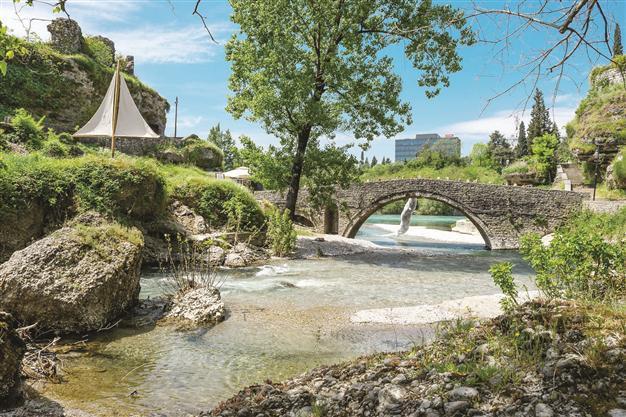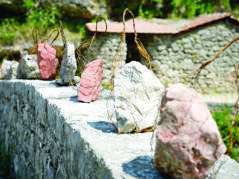Montenegro women's problems revealed in Turkey
ISTANBUL – Hürriyet Daily News

This photo shows a set up thst Montenegrin artists Gordana Kuc, Ivanka Vana Prelevic and Nada Kazic and Turkish artists Işıl Eğrikavuk, Merve Sendil and Sümer Sayın made on April 27 2013 near Ribnica River.
Istanbul will be hosting women artists from Montenegro and Turkey to present their projects highlighting the cultural identity of women in the Podgorica town of Montenegro. The project’s central event is a joint exhibition in Podgorica, where all six artists presented their installations to the audience by the Ribnica riverside. The artists will then gather to present their works in Istanbul as part of the second part of the project on Sept. 3, at the city’s Mixer gallery.Titled “Penelopolis: Women’s Cultural Map of Euro-Mediterranean Town,” six female visual artists participates in the project to shed light on their experiences and create a literal map of the region reflecting these backgrounds. Through their artistic interventions in the form of objects and spatial installations, the artists made marginalized women’s cultural identities visible. By creating a new town cultural map that, unlike the official town cultural maps that mark only the places of majority cultural identities, recognizes and accepts the significance of minority identities, their influence on the town’s contemporary identity and the importance of marginalized cultural heritage in that context.
Since its establishment, Montenegro has been defined as a country connecting the great monotheistic religions and places of worship: Roman Catholic, Orthodox and Islam.
Gathering cultures
In the cultural aspect, the country is seen as combining East and West, between the Mediterranean and a hinterland. Over time, therefore, different civilization layers have shaped the complex and diversified heritage upon which contemporary Montenegro is built.
In a place like this one would hope not to see inequalities or gender problems. However, the situation is rather different. According to a 2010 report by CEDAW, titled “The Condition of Women’s Human Rights in Montenegro,” 35 percent of men and 68.6 percent of women claim that women are discriminated against in Montenegro.
When these facts are considered, the exhibition could be said to combine the two discriminatory worlds of Turkey and Montenegro. The reason that Montenegro-based artists worked with Turkey-based artists might be seen as a way to create a new understanding between the women of both countries.
Discrimination in Turkey is mainly seen in society as simply a part of women’s life. According to a World Bank report on gender inequality published on 2011, equality of opportunity between women and men is very low in Turkey, and women mostly lack the opportunities that men have.
The CEDAW report published in 2005 showed that while Turkey has quite a high participation of women in professions, and granted the vote to women in the 1930s, it still faces significant gender inequalities in property ownership, literacy ratio, labor force participation, political representation and visibility.
Women’s place in society
The Hürriyet Daily News reported in December 2012 that the World Bank’s 2012 Gender Equality and Development Report showed there was a major gap between men’s and women’s labor force participation rates in Turkey. While the world average of female participation in the labor force was almost 60 percent, in Turkey it was less than 30 percent on average (Hürriyet Daily News, December 2011). “Women’s participation in the labor force is one of our weakest areas. As long as we cannot change the employment rates, which are 70 percent for males and 30 percent for females, it seems difficult to reach international levels of development,” Family and Social Policies Minister Fatma Şahin had earlier stated (Hürriyet Daily News, December 2011).
 When place and situation considered, considerable similarities therefore emerge between Turkey and Montenegro, which are key for the artists who worked in the project.
When place and situation considered, considerable similarities therefore emerge between Turkey and Montenegro, which are key for the artists who worked in the project.The chosen Turkish artists - Işıl Eğrikavuk, Merve Şendil and Sümer Sayın - set up their installations in Podgorica in light of all these similarities. The artists tried to reveal the marginalized, lost and dispersed traces of Podgorica, while also trying to show the impact of women’s cultural expression in the city.
All three artists from Turkey tried to emphasize women’s situation in terms of inequality in culture.
While Merve Şendil’s project is directly related to the women in Podgorica and focuses on inequality and how women and men do not have the same opportunities in Montenegro, it also reflects the cultural heritage in the geography. Şendil also touches on local and traditional culture itself, revealing the more traditional aspects of identity for women in Montenegro.
Işıl Eğrikavuk’s work focuses on more universal issues, such as women’s killings. In addition, the cultural identity that women carry as they migrate to other places is another asset of her project. The migration of women and the cultural identity that women create as they move to different places is the focus of her video.
Eğrikavuk questions the heritage of women and how it changes in time as they migrate or are forced to migrate. She tries to explain why women’s heritage always tends to remain invisible in male-oriented cultures.
Sümer Sayın’s project combines history and culture with Montenegro’s past. For her piece, Sayın searched through the important and significant female aspects existing in the history books, flags, ancient artworks and museums of Montenegro. Later on, she decided on a more balanced flag of Podgorica and used it as a metaphor.
















